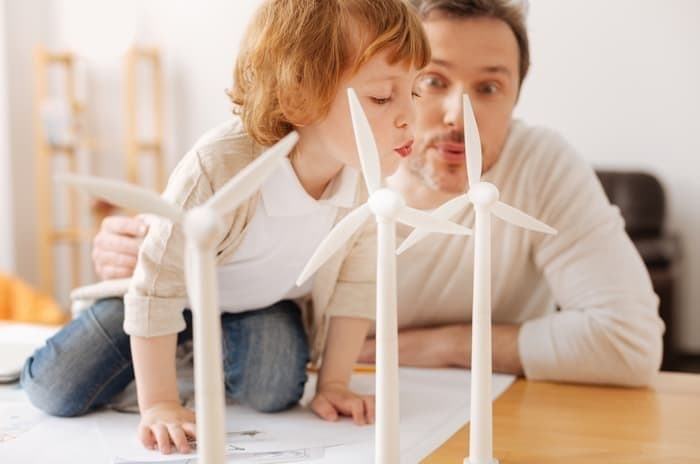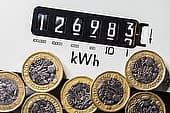There are almost 500 community energy organisations active across the UK operating electricity generation projects or providing energy efficiency support and installations among other initiatives.
In 2021, these electricity generators produced enough power to run 174,000 households.
However, a lack of coherent Government support and poor policy decisions have stopped the sector from flourishing in recent years.

What is community energy?
Community energy is exactly what it sounds like - energy generated by a community for the use of that community.
By pooling resources and working together, community energy projects allow local communities to access cheaper energy and improved energy efficiency options, along with adding social and economic benefits to local areas.
There are four distinct strands of community energy:
- Reducing energy use
- Managing energy more efficiently
- Generating energy
- Purchasing energy
However, while community energy projects were heralded in 2014 as the next big thing in local energy provision, visible support from the Government has mostly disappeared, and the last update to their strategy was way back in 2015.
Policy changes relating to renewable tariffs have also impacted how economically viable community energy projects can be, yet the opportunities of community energy enterprises are still as valid as ever.
Later in this guide, we'll take a look at the obstacles that communities may run into when trying to set up their project, but first we'll look at the types of community energy projects groups can undertake.
Types of community energy
Community Energy, comprising of organisations across the UK, issue annual reports to show how the community energy market is performing.
Their most recent report, State of the Sector 2022, provides some key statistics about community energy projects in 2021:
- There are 495 community energy organisations across the UK, up by 18 compared to 2020 and a significant increase on the 275 identified in their State of the Sector 2019 report
- 23 new electricity generating projects were created
- 7.5 MW of new renewable electricity capacity was installed
- £21.5 million was raised for investment in new projects across the UK
There are five distinct areas organisations are involved in:
- Electricity generation
- Energy storage
- Energy efficiency
- Heat generation
- Low carbon transport
However, it's significant that none of the 18 new organisations reported involvement with active electricity generation projects and were instead focused on energy efficiency, low carbon transport and renewable heat initiatives.
Community Energy suggests this is due to the perceived difficulties of getting electricity projects started following regulatory changes in recent years - more on that later.
First, let's look at what these community-led organisations are achieving.
1. Electricity generation
Communities can install renewable energy generation projects in their local areas to harness solar, wind or hydro power.
By December 2018, there were community generation sites across England, Wales and Northern Ireland amounting to 168 MW of generation capacity. The majority of this was solar (138.3 MW), while wind (27.4 MW) and hydro (2.2 MW) trailed behind.
This had increased to 271 community generation sites across the UK by December 2021 amounting to 331 MW of generation capacity.
Again, solar was in the lead (206 MW) with wind in second place (113 MW) and hydro in third (12 MW).

In practice, this means:
- 506 GWh of electricity is generated by these projects annually
- 174,000 households are powered by this electricity
- The equivalent of 143,000 tonnes of carbon dioxide is saved
Yet the growth rate for community electricity capacity in 2021 was only 2.4%, less than half of the growth seen in 2020 and significantly below the 18% seen in 2018.
2.Energy storage
Energy storage is a crucial element of properly utilising any energy generated from renewable sources.
11% of community energy organisations are involved in energy storage or energy flexibility services, many of which are connected to a larger generation project.
That said, the upfront costs associated with a battery storage community project are high, so the successful ones tend to be supported by innovation grants or developed in conjunction with universities or commercial partners.
The capacity of community-owned energy storage in 2021 increased by 154 kWh to 1.9 MWh.
3. Energy efficiency
Local groups can undertake activities to help their communities improve the energy efficiency of their homes, whether this is through acting as advisers to others or working to implement changes themselves through grants and funding schemes.
More community energy groups were engaged in helping improve energy efficiency measures in 2021 than previously with 123 said to have undertaken such projects. As a result:
- 57,600 individuals/communities were engaged by these initiatives
- 20,843 households received building improvements at a cost of over £510,000
- £3.35 million was saved on energy bills
Many of the 123 organisations provided services free of charge (71%) while a further 25% offered both free and paid services and 14% operated a paid-only model.
The most common types of community energy efficiency advisory projects were:
- Advice and support to install renewable tech
- Funding advice
- Fuel poverty reduction
- Workshops and cafes
- Building assessments and audits
Meanwhile, improvement services to install energy efficient lighting were the most common deliverable for organisations actively installing improvements for energy customers.
With a focus on reducing the amount of energy needed by households, the bills of those involved in community energy efficiency projects could be reduced.
However, as many of these initiatives act as local advisers rather than installers of energy efficiency, the impact could be limited.
4. Heat generation
Until March 2021, subsidies were still available for heat generation technologies under the Renewable Heat Incentive (RHI).
This ostensibly included support to community energy groups hoping to take advantage, but the reality is that very few were being installed.
Community Energy figures show that:
- Only three new heat installations were reported in 2021 with a capacity of 138 kW and two of them secured RHI support
- All three projects involved heat pumps
- There are 28 organisations developing heat projects with 4.7 MW total community-owned heat capacity
The different types of heat generation activity making up that capacity are:
- Biomass
- Ground source heat pump
- Biomass
- Solar thermal
- Air source heat pump
For communities, it can be difficult to get involved with heat generation opportunities because of the high installation costs of networks and transmission systems. The lack of more working examples can also put communities off engaging with this type of energy.
5. Low carbon transport
Finally, low carbon transport is one of the lesser-known possibilities for community energy, but there were 90 organisations actively involved in this area in 2021.
The State of the Sector 2021 report broke them down as follows:
- Electric vehicles (23%)
- Car share (17%)
- EV charging (30%)
- EV education (11%)
- E-bike (18%)
- Other (2%)
The report highlighted a shift away from EV ownership models, noting a reduction in the number of activities focused exclusively on EV and charging point ownership.
While those initiatives are still popular, activities to facilitate car sharing, education and infrastructure improvements are also becoming more common.
Benefits of community energy
So, now we've explored the different types of community energy projects taking place across the UK, it's worth stepping back and looking at what the benefits of community energy are.
These can be split into two categories: economic and social.
Economic benefits
Any community energy initiative will likely be of economic benefit to a local area, with both direct and indirect economic impacts noted:
- Low cost energy generation for homes, community buildings and schools
- Reduction of fuel poverty
- Dividend payments to local investors
- Cost savings for locals when energy efficiency upgrades are implemented
- Reduced transportation cost when EV charging infrastructure is introduced
- Local job creation
- Development of community benefit funds to prolong impact
- Local economic resilience
When considering these economic benefits, though, it's important to remember there will have to be initial outlay for the project, whether that's in money or in time.
As the removal of subsidies and the closure of Government grant schemes has started to bite, community organisations who aren't confident in their ability to manage the financial side of projects aren't progressing with energy generation schemes. It seems they're more likely to opt for helping others undertake energy efficiency measures in advisory roles.
Social benefits
Alongside economic benefits, there are social benefits to being involved in a community energy project, and these can spread beyond the initiative itself. They may not be as straightforward to measure as economic benefits, but they exist all the same.
These are some examples:
- Increased community confidence at being able to achieve something together
- Improved community cohesion and local social opportunities
- Potential for increased local prosperity strengthens community
- Community benefit funds can be funnelled into local priorities
- Help education of energy efficiency further afield in the area
Some supporters of community energy say the social benefits of projects aren't highlighted enough, and that the public could be better engaged.

Community motivations
The annual State of the Sector reports examine why communities are motivated to carry on starting and delivering community energy projects even with the challenges facing them.
These were the reasons organisations cited as being of high importance:
- Reducing Co2
- Community ownership of assets and land
- Developing local support for renewable energy
- Local retention of community income
- Capacity building and skills
- Alleviating fuel poverty
- Reducing unsustainable land use practices
Within that list, there are motivations that fit into both environmental and social categories, along with a desire to reduce Co2 which was cited as a core goal by 65% of respondents.
Why isn't community energy more widespread?
Given all the potential benefits and the different types of community energy initiative available, it seems strange that more communities aren't yet involved.
We've alluded to some of the reasons for this already, but now we'll look at some of the major issues.
Feed-in Tariff
Perhaps one of the most damaging policy decisions of recent years has been the closure of the Feed-in Tariff (FiT) scheme which closed to new entrants in March 2019.
This meant community organisations hoping to install solar panels after that point wouldn't be able to sell excess energy back to the grid, although this was always intended to be an interim measure until a new scheme was introduced.
The Smart Export Guarantee (SEG) was announced in June 2019 and came into force on 1 January. This requires energy companies with over 150,000 customers to have export tariffs available for customers.
However, the scheme has been criticised by supporters of community energy projects because there's no framework to help reward community groups providing economic, environmental and societal benefits.
SEG doesn't seem to incentivise community energy at all, which brings us to our next point.
Lack of Government policy
As we've already mentioned, the last major update to community energy guidance on the official Government website was way back in January 2015, marking seven years of inaction on the subject.
While it's easy to find a political reason for this (the minister responsible in the coalition for pushing the policy was Lib Dem MP Ed Davey), it doesn't make it any less infuriating when you consider all the excellent elements of community energy we've discussed in this guide.
It isn't simply a case of community groups not having access to funding and grants, but the lack of a cohesive policy impacts every aspect of the process.
For instance, community groups can have difficulty securing planning permission, and with no Government backing, it can be complex to argue their cases with local authorities.
While many existing groups are persevering in the face of these policy challenges, it's little wonder others are being put off.
Some politicians have recognised this as a serious issue.
The Environmental Audit Committee wrote to the Secretary of State at the Department for Business, Energy and Industrial Strategy following an inquiry in early 2021 to criticise the lack of movement on community energy.
In a response, the Secretary of State pointed out that the SEG will be reviewed with the aim of assessing how it's working for small-scale generators.
However, since then, policy seems to have remained stagnant.
Lack of skills
Even if a community organisation has the best of intentions, getting any project off the ground and maintaining it for the long-term requires individuals with different skillsets. For example, being able to negotiate leases is a skill that many people lack due to the simple fact they've never had to develop it.
In addition, many organisations are volunteer led. Yet this can lead to frustration if enough time can't be devoted to the necessary tasks or breed the exact opposite to social cohesion if some individuals feel they're doing more of the work than the rest of the community.
Other issues
There are other specific issues that we won't go into here, but we'd recommend looking at the State of the Sector report for a more comprehensive analysis.
Their research with existing community groups has found some reoccurring themes in the sort of support they feel they need. In order of reoccurrence, here's the list:
- Time and capacity
- Early stage funding
- Expert support
- Lower Grid connection costs
- Guidance with new business models
- Reduced planning complexity
- Assistance to recruit volunteers
- Better loan rates
It's easy to see the sector is crying out for support, so we can only hope the Government listens and moves to build on the projects already underway to create more momentum around community energy.
Schemes and grants
Many Government schemes have permanently closed, but that doesn't mean there aren't still some opportunities for community groups hoping to get involved in community energy projects. These range from grant funding based around specific principles, location-based grants and more general funding and financing organisations.
These change frequently, but Community Energy England have an up-to-date list. Bear in mind, these aren't the only ones available, and be sure to check Scottish grants if you're eligible for those.
Summary: Support needed
Although there are significant problems surrounding community energy schemes right now, the principles of local organisations generating and storing energy, providing support and investing in EV transport are sound.
Groups have been lobbying for the rejuvenation of community energy schemes for several years now, with the Green Alliance pointing out in 2019 that Government strategy changes have left community energy groups struggling to put forward effective business cases.
In essence, little has changed over the last three years but, as the Community Energy State of the Sector 2022 report demonstrates, some organisations are still emerging despite the lack of support to improve energy efficiency in their local areas.
Community Energy admit the sector is in a challenging situation and conclude their report with a three-point wish list:
- A Community Energy Strategy must be created to invest and re-mobilise the community energy sector
- Demand reduction and behaviour change must be boosted and prioritised
- Action must be taken to put community energy at the heart of the roll-out of Smart Local Energy Systems and Local Area Energy Planning
Community Energy isn't alone in making these types of suggestion and the Environmental Audit Committee has also been vocal about them.
However, it remains to be seen whether this can have a significant impact on Government policy in the years ahead.









Comments